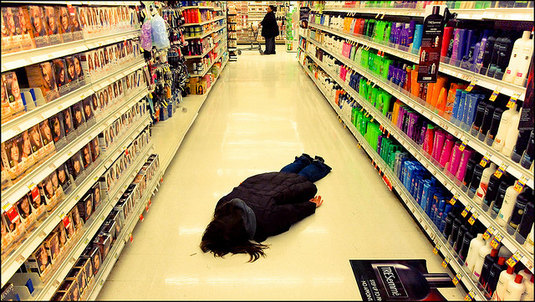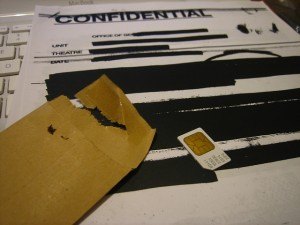Information empowers businesses and consumers, so it’s little surprise that stores with horrible pricing dislike it when people record said pricing in store.

Tesco’s staff dislike it so much, they threatened The Guardian’s Patrick Collinson, saying that it was against the law to write the store’s prices down in a notebook:
“The security cameras had spotted me with a pen and paper in hand, noting the prices of goods on the shelves. “Excuse me, what are you doing?” he said. I told him I was, well, writing down prices.
‘You’re not allowed to do that. It’s illegal. Where are you from? Are you from the media?’…
‘It’s illegal to write things down and you can’t take any photographs, either. If you want to check the prices, take the item to the till and pay for it there. The price will be on the receipt,’ he said, pointing me to the exit.”
A Guardian commenter accurately analyzes this:
“Just for the avoidance of doubt, in legal terms this is what is technically known as ABSOLUTE BALLS.”
This intrigued me, so I decided to test it out in New Zealand’s supermarkets.
The test
I visited Countdown, FreshChoice, New World and Pak’nSave with notebook in hand and hunted down six items in each store:
- Toothpaste
- Baked beans
- Coke
- Kiwifruit
- Bread
- Milk
I thought this would be a good range, and took me down the toiletries aisle, which invariably seems to be under video surveillance.
And…
Nothing happened. I wasn’t approached by anyone, and left each store without buying anything and without being questioned.
Because it would be anti-climatic to end on that note, let’s end with an exciting price comparison competition pseudo-table.
The prices
Toothpaste
Colgate Triple Action, in various sizes. ($price) is per 100g.
Countdown:
- 80g $1.99 from $2.55 ($2.49) (non-special: $3.19)
- 110g $2.99 ($2.72)
- 160g $2.99 from $4.08 ($1.87) (non-special: $2.55)
- 220g $5.00 ($2.27)
FreshChoice:
- 110g $2.99 ($2.72)
- 160g $2.99 from $4.65 ($1.87) (non-special: $2.91)
- 220g $5.10 ($2.32)
New World:
- 110g $2.79 ($2.54)
- 160g $4.09 ($2.56)
- 220g $3.99 from $5.56 ($1.81) (non-special: $2.53)
Pak’nSave:
- 110g $2.67 ($2.43)
- 160g $2.99 from $3.79 ($1.87) (non-special: $2.37)
- 220g $3.95 from $5.45 ($1.80) (non-special: $2.48)
Winner: New World. Everyone else is disqualified for their batshit pricing, like the 110g and 160g tube prices being the same, and stores thinking it’s cool to keep the 110g one on the shelf; and the 220g bulk value tube actually ending up more expensive.
Baked beans
Wattie’s 300g can.
Countdown:
- $1.85
FreshChoice:
- $1.89 from $2.03
New World:
- $1.85
Pak’nSave:
- $1.79
Winner: Pak’nSave
Coke
1.5L Coca-Cola.
Countdown:
- $3.05
FreshChoice:
- $3.05
New World:
- $3.05 or three for $6.00
Pak’nSave:
- $1.89 (this was apparently on special but I couldn’t find the non-special price)
Winner: Pak’nSave
Kiwifruit
Cheapest per kg
Countdown:
- $3.98 or $3.95 depending on what sign you look at
FreshChoice:
- $3.69
New World:
- $3.99
Pak’nSave:
- $3.99
Winner: FreshChoice
Bread
What looked like the cheapest 600g and 700g loaves (there are lots of loaves). ($price) is per 100g.
Countdown:
- 600g $1.69 ($0.28)
- 700g $3.99 ($0.57)
FreshChoice:
- 600g $1.71 ($0.29)
- 700g $2.79 ($0.40)
New World:
- 600g ???//klhlk
- 700g $1.99 ($0.28)
Pak’nSave:
- 600g $1.65 ($0.28)
- 700g $1.89 ($0.27)
Winner: Pak’nSave
Milk
Cheapest 2L trim.
Countdown:
- $3.49
FreshChoice:
- $3.49
New World:
- $3.49
Pak’nSave:
- $3.49
Winner: If we were in school: EVERYONE!!! But because this is the real world, no one wins.
Pak’nSave is the grand winner. New World and Pak’nSave win bonus prizes for actually doing price per 100g etc. price comparison on their labels.
See, that was fun.
Image credit: Richard Giles and Erin! Nekervis

 Scarier, is that computers and files containing confidential information, in this case
Scarier, is that computers and files containing confidential information, in this case